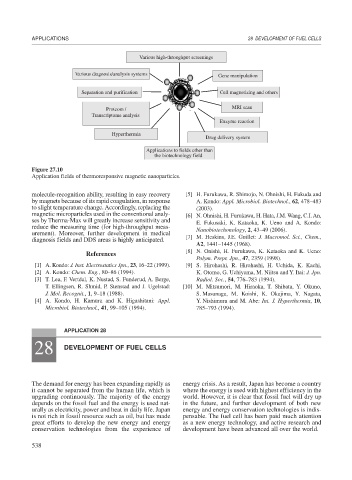Page 566 - Book Hosokawa Nanoparticle Technology Handbook
P. 566
APPLICATIONS 28 DEVELOPMENT OF FUEL CELLS
Various high-throughput screenings
Various diagnosis/analysis systems Gene manipulation
Separation and purification Cell magnetizing and others
Proteom / MRI scan
Transcriptome analysis
Enzyme reaction
Hyperthermia
Drug delivery system
Applications to fields other than
the biotechnology field
Figure 27.10
Application fields of thermoresponsive magnetic nanoparticles.
molecule-recognition ability, resulting in easy recovery [5] H. Furukawa, R. Shimojo, N. Ohnishi, H. Fukuda and
by magnets because of its rapid coagulation, in response A. Kondo: Appl. Microbiol. Biotechnol., 62, 478–483
to slight temperature change. Accordingly, replacing the (2003).
magnetic microparticles used in the conventional analy- [6] N. Ohnishi, H. Furukawa, H. Hata, J.M. Wang, C.I. An,
ses by Therma-Max will greatly increase sensitivity and E. Fukusaki, K. Kataoka, K. Ueno and A. Kondo:
reduce the measuring time (for high-throughput meas- Nanobiotechonology, 2, 43–49 (2006).
urement). Moreover, further development in medical [7] M. Heskins, J.E. Guillet: J. Macromol. Sci., Chem.,
diagnosis fields and DDS areas is highly anticipated.
A2, 1441–1445 (1968).
[8] N. Onishi, H. Furukawa, K. Kataoka and K. Ueno:
References
Polym. Prepr. Jpn., 47, 2359 (1998).
[1] A. Kondo: J. Inst. Electrostatics Jpn., 23, 16–22 (1999). [9] S. Hirohashi, R. Hirohashi, H. Uchida, K. Kachi,
[2] A. Kondo: Chem. Eng., 80–86 (1994). K. Otomo, G. Uchiyama, M. Niitsu and Y. Itai: J. Jpn.
[3] T. Lea, F. Vertdal, K. Nustad, S. Funderud, A. Berge, Radiol. Soc., 54, 776–783 (1994).
T. Ellingsen, R. Shmid, P. Stenstad and J. Ugelstad: [10] M. Mitsumori, M. Hiraoka, T. Shibata, Y. Okuno,
J. Mol. Recognit., 1, 9–18 (1988). S. Masunaga, M. Koishi, K. Okajima, Y. Nagata,
[4] A. Kondo, H. Kamura and K. Higashitani: Appl. Y. Nishimura and M. Abe: Int. J. Hyperthermia, 10,
Microbiol. Biotechnol., 41, 99–105 (1994). 785–793 (1994).
APPLICATION 28
28 DEVELOPMENT OF FUEL CELLS
The demand for energy has been expanding rapidly as energy crisis. As a result, Japan has become a country
it cannot be separated from the human life, which is where the energy is used with highest efficiency in the
upgrading continuously. The majority of the energy world. However, it is clear that fossil fuel will dry up
depends on the fossil fuel and the energy is used nat- in the future, and further development of both new
urally as electricity, power and heat in daily life. Japan energy and energy conservation technologies is indis-
is not rich in fossil resource such as oil, but has made pensable. The fuel cell has been paid much attention
great efforts to develop the new energy and energy as a new energy technology, and active research and
conservation technologies from the experience of development have been advanced all over the world.
538

